Today in Int 2 IS we learned about the different protcols in TCP/IP (transfer control protocol and internet protocol)
The 4 main internet service protocols that we learned about are:
HTTP – is the service protocol that allows users to receive information from the World Wide Web
FTP – allows users to send (or receive) copies of files from or to different computer systems or networks.
SMTP – is generally the protocol used to send outgoing email messages
POP3 – is generally the protocol used to receive incoming email messages
Transmission Control Protocol (TCP) is concerned with taking a data message, breaking it into smaller chunks called packets and then re-assembling it again at the other end.
This is a link to tell you more about TCP http://simple.wikipedia.org/wiki/Transmission_Control_Protocol
This is a link to tell you more about IP http://simple.wikipedia.org/wiki/Internet_Protocol
By Colin







